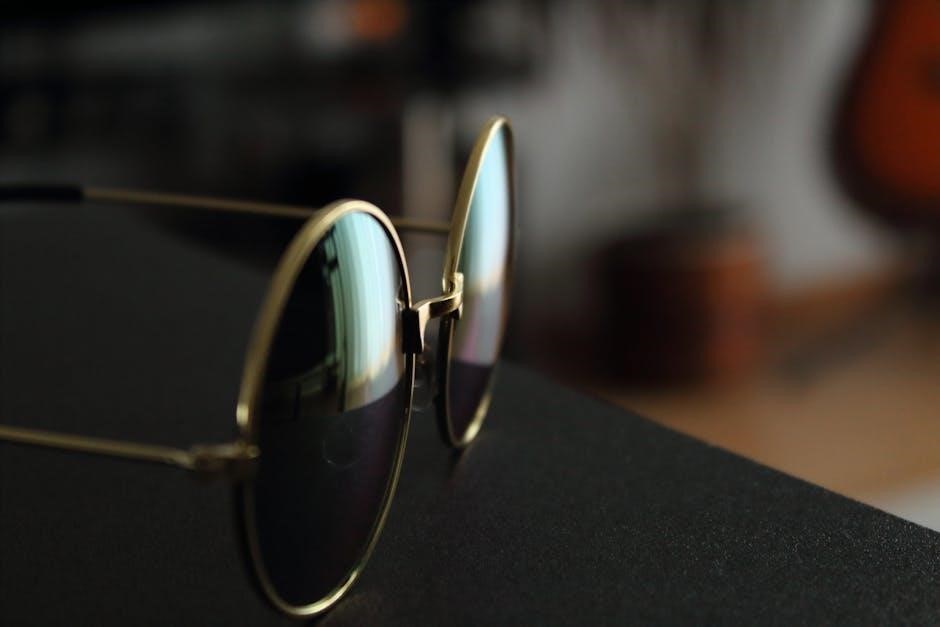Choosing the right sunglasses frame size is essential for both comfort and style. This guide helps you understand measurements, face shapes, and how to find your perfect fit.
Why Frame Size Matters for Sunglasses
Properly fitting sunglasses are crucial for comfort, functionality, and style. A frame that is too small may cause discomfort or inadequate coverage, while one that is too large can slip down or look unbalanced. Correct sizing ensures optimal UV protection, reduces glare, and enhances visual clarity. It also complements your face shape, balancing features for a flattering look. Measuring key dimensions like lens width, bridge size, and temple length helps determine the ideal fit. A well-fitting frame ensures long-lasting wearability and maximizes the benefits of your sunglasses.

Key Measurements for Sunglasses Frames
Key measurements include lens width, bridge size, temple length, and lens height. These dimensions ensure proper fit, comfort, and coverage, essential for functionality and style.
Lens Width: The Most Important Measurement
Lens width is the most important measurement for sunglasses frames, typically ranging from 40mm to 60mm. It determines how the sunglasses fit and look on your face. A larger lens width offers more coverage and a bolder style, while smaller widths suit narrower faces or minimalist designs. This measurement is crucial for both functionality and aesthetics, ensuring proper protection and comfort. Lens width is usually the first number in frame measurements and is essential for selecting frames that complement your face shape and personal style.
Bridge Size: Connecting the Lenses
Bridge size, measured in millimeters, is the distance between the two lenses at the thinnest part of the frame. It ensures proper fit and comfort, especially for the nose. A well-fitting bridge prevents slipping and discomfort. While lens width is more critical, bridge size plays a key role in overall comfort and stability. It varies depending on face shape and personal preference, ensuring the sunglasses align with your facial proportions for a balanced and stylish look.
Temple Length: The Arms of the Sunglasses
Temple length refers to the measurement of the arms of the sunglasses, from the hinge to the tip. It ensures the sunglasses fit securely around your ears without causing discomfort. Proper temple length is crucial for stability and comfort, preventing the frames from slipping down. Typically measured in millimeters, temple length varies between 135mm to 150mm for most adults. To measure, use a ruler to gauge the distance from the hinge to the temple tip. Ensuring the right temple length guarantees a comfortable and secure fit, making your sunglasses more enjoyable to wear all day long.
Lens Height: Ensuring Proper Coverage
Lens height measures the vertical size of the sunglasses’ lenses, ensuring proper coverage for your eyes. It determines how much of your face is shielded from sunlight and UV rays. Taller lenses offer more protection, while shorter ones provide a stylish, low-profile look. Lens height is particularly important for activities like driving, where light can enter from above. When choosing, consider your face shape and desired coverage. Proper lens height ensures optimal comfort, functionality, and aesthetic appeal, making it a key factor in selecting the perfect sunglasses for your needs. Measure your existing frames or use a ruler to find your ideal fit.

Determining Your Face Shape
Determining your face shape is crucial for selecting sunglasses that fit well and complement your features. Common shapes include oval, square, round, heart, and diamond, each requiring specific frame styles.
How to Identify Your Face Shape
To identify your face shape, start by pulling your hair back and examining your face in a mirror. Measure or estimate the proportions of your face. Oval faces are longer than wide, with balanced features. Square faces have a strong jawline and similar length and width. Round faces are curved with full cheeks and appear shorter. Heart-shaped faces have a wide forehead and temples, narrowing at the chin. Diamond faces are narrow at the top and bottom, with wide cheekbones. By understanding these characteristics, you can determine your face shape and choose sunglasses that complement it.
Recommended Frame Styles for Each Face Shape
Oval faces suit most frame styles, especially aviators and wayfarers. Square faces look best with rounded or soft-edged frames to balance sharp angles. Round faces are complemented by angular or rectangular frames for contrast. Heart-shaped faces benefit from cat-eye or aviator styles that draw attention downward. Diamond faces pair well with rimless or oval frames to enhance width. By matching your face shape to the right frame style, you can achieve a balanced, flattering look that enhances your features and personal style while ensuring a comfortable fit.

How to Measure Your Existing Frames
Measure lens width, bridge size, and temple length using a ruler. Check the inside of the temple for size markings, typically in millimeters, to determine fit.
Measuring Lens Width and Bridge Size
Measure lens width by determining the horizontal distance of one lens in millimeters. Bridge size is the distance between the inner edges of the lenses; Both measurements ensure proper fit. Lens width impacts coverage and style, while bridge size affects comfort. Use a ruler to measure these accurately. If unsure, check the temple for size markings, typically in millimeters. These measurements help determine the frame’s proportions and ensure the sunglasses sit comfortably on your face, providing adequate coverage and protection.
Understanding Temple Length and Hinge-to-Hinge Distance
Temple length refers to the measurement of the arms of the sunglasses, from the hinge to the tip, ensuring they fit comfortably behind your ears. Hinge-to-hinge distance measures the total width of the frame, including both lenses and the bridge. These measurements are crucial for ensuring the sunglasses stay in place without slipping. While temple length focuses on the arms’ fit, hinge-to-hinge distance provides the overall width for proper alignment with your face. Both measurements vary by brand and style, so comparing them to your existing frames or using a size chart can help determine the best fit for you.

Converting Measurements to Frame Size
Measure your face width using a ruler and align it with standard frame sizes to ensure a proper fit and optimal coverage for your eyes and face shape.
Using a Ruler to Measure Your Face
To determine your ideal frame size, measure your face using a ruler. Start by measuring the width between your temples for the overall frame fit. Next, measure the bridge size by placing the ruler vertically across the narrowest part of your nose. Finally, measure the lens height by determining the vertical size of your eye area. Use a mirror for accuracy and ensure the ruler is aligned properly. Take multiple measurements to confirm consistency. This method helps match your face dimensions to standard frame sizes for a precise fit.
Matching Your Measurements to Standard Sizes
Once you have your face measurements, compare them to standard frame size charts to find your ideal fit. Lens width, bridge size, and temple length are key factors. Standard sizes are often categorized as Small, Medium, or Large, with specific millimeter ranges for each. For example, a lens width of 48-55mm typically falls under Medium. Use this data to align your measurements with predefined sizes for accurate fitting. This step ensures your chosen sunglasses will complement your face proportions and provide optimal comfort.
Referencing size charts from manufacturers or retailers can further refine your selection, as sizing may vary slightly between brands.

Sunglasses Size Chart
A standard size chart categorizes frames by lens width, bridge size, and temple length, often labeled as Small, Medium, or Large for easy selection.
Understanding Numerical Size Labels
Numerical size labels on sunglasses frames typically refer to the lens width, bridge size, and temple length in millimeters. These measurements are crucial for ensuring a proper fit and comfort. For example, a frame labeled 52-18-145 indicates a 52mm lens width, 18mm bridge size, and 145mm temple length. These measurements help determine if the frames will suit your face shape and size. While numerical labels are standard, some brands may vary slightly, so comparing measurements or trying frames on is recommended for the best fit. Always check the size chart for accurate sizing.
Generic Size Labels (Small, Medium, Large)

Generic size labels like Small, Medium, and Large are commonly used to categorize sunglasses frames based on their overall dimensions. While these labels are convenient, they can be less precise than numerical measurements. For instance, a Medium frame might correspond to a lens width of 48-55mm, while a Large frame could exceed 55mm. Some brands also offer Extra Large sizes for wider faces. However, these labels can vary between brands, making them less reliable for ensuring an exact fit. Trying frames on or referencing a size chart is often the best way to confirm sizing accuracy for comfort and style.

Additional Considerations for Frame Size
Beyond measurements, consider hinge-to-hinge distance for overall fit and face proportions to ensure frames complement your features, balancing aesthetics and comfort seamlessly.
Hinge-to-Hinge Distance and Frame Proportions
The hinge-to-hinge distance measures the total width of the frame, including the temples, ensuring proper alignment with your face. This measurement, often linked to lens width and bridge size, affects comfort and style. Proportions matter; frames should balance your facial features without overwhelming them. While standard sizes fit most, variations exist, so trying frames or using a sizing guide can help determine the best fit for your unique face shape and preferences.
Face Proportions and Frame Width
Face proportions play a crucial role in determining the ideal frame width for sunglasses. Measure your face width across the temples to ensure the frames align perfectly. Wider faces suit larger frames, while narrower faces benefit from slimmer styles. The frame width should complement your facial structure, balancing features without overwhelming them. Standard sizes often range from small to extra-large, but proportions vary by brand. Ensure the frames feel comfortable and visually harmonize with your face shape for the best fit. Trying frames or using a sizing guide can help confirm the perfect match.

With the right measurements and understanding of your face shape, finding the perfect sunglasses fit is straightforward. Use this guide to enhance comfort, style, and eye protection.
Final Tips for Finding the Perfect Fit
To ensure your sunglasses fit perfectly, consider measuring your face or using a well-fitting pair as a reference. Use a ruler to measure lens width, bridge size, and temple length accurately. Virtual try-on tools can also help you visualize how frames look on your face. Remember, frames should align with your eyebrow line and not exceed your face width. Additionally, check the hinge-to-hinge distance for proper proportions. By balancing style and practicality, you can find sunglasses that offer both comfort and protection while enhancing your appearance.


